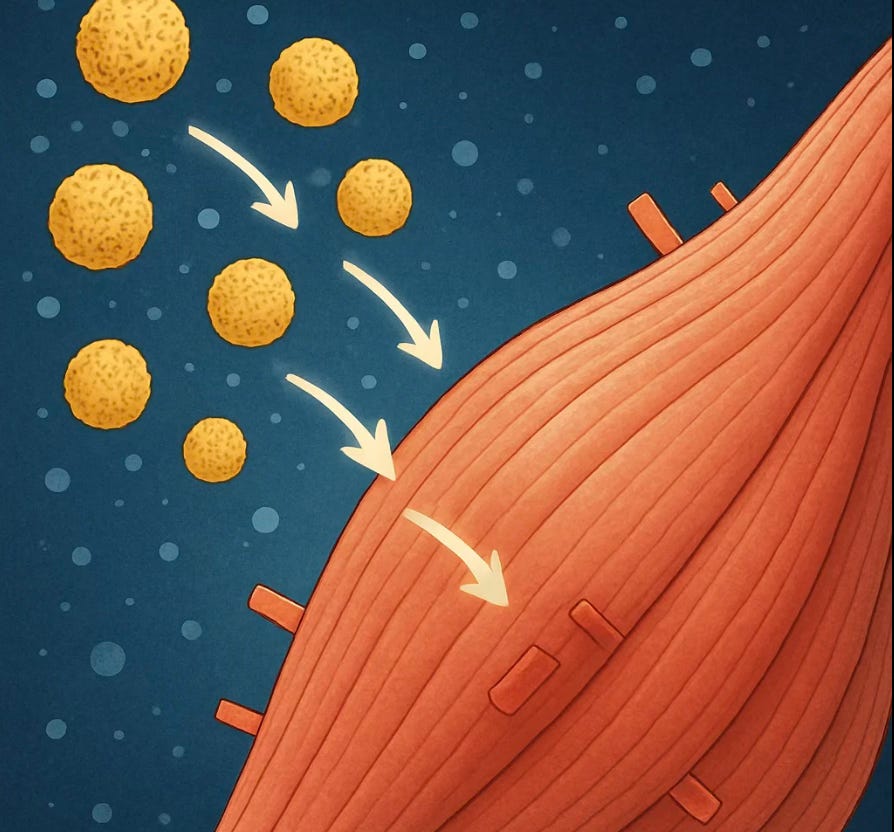Landmark Study Validates "Food as Information": Whey Protein Exosomes Override Classical Nutrition Paradigms
How Tiny Cellular Messengers in Food Reprogram Human Biology Beyond Traditional Nutritional Models
A landmark study published in the Journal of Dairy Science validates a core premise I've been advancing in my work REGENERATE: food is not merely fuel, but biological code. This research reveals how our conventional understanding of nutrition—focused primarily on calories, macronutrients, and isolated compounds—fails to capture the profound informational transfer that occurs when we consume whole foods.
The Groundbreaking Discovery: Whey Protein's Hidden Communication System
In "Whey protein-derived exosomes increase protein synthesis and hypertrophy in C2C12 myotubes," Mobley and colleagues at Auburn University demonstrated that whey protein contains biological messengers that transcend conventional nutritional understanding.
Their study revealed that exosomes isolated from hydrolyzed whey protein increased muscle protein synthesis (MPS) by approximately 46% compared to control conditions, significantly outperforming both leucine (+24%) and essential amino acids (+25%). Most remarkably, when researchers genetically silenced the primary leucine transporter (LAT-1), the anabolic effects of isolated leucine were abolished, yet whey protein-derived exosomes continued to stimulate protein synthesis.
This finding challenges fundamental assumptions about protein nutrition. It suggests that whey's effects on muscle growth aren't solely attributable to its amino acid content, but also to nanovesicles containing microRNAs and other signaling molecules that operate through distinct cellular pathways.
The researchers confirmed that these exosomes increased myotube diameter by up to 40% after 48 hours of treatment and influenced protein synthesis through mechanisms independent of the conventional mTOR signaling pathway typically activated by amino acids. Instead, they increased expression of translation initiation factors, particularly eIF4A.
Perhaps most significantly, the study detected bovine-specific microRNAs (including miR-149-3p) within the treated muscle cells—direct evidence of cross-species genetic information transfer from food to human cells.
The Remarkable Benefits of Quality Whey
The informational properties of whey protein help explain why it demonstrates over 50 evidence-based health benefits, ranging from enhanced immune function and glutathione production to improved cognitive performance and metabolic health. As I've documented extensively in my research, whey's biological effects extend far beyond its amino acid profile, affecting virtually every system in the body.
Critically, the source and quality of whey matter tremendously. Just as software with corrupted code fails to function properly, the biological information in dairy can be compromised. Consider the relatively recent mutation (approximately 8,000 years ago) that created A1 beta-casein milk, which differs from the original A2 casein by a single amino acid substitution—essentially a biological software glitch. This mutation causes the release of beta-casomorphin-7, a peptide linked to various inflammatory conditions and digestive disturbances in sensitive individuals.
The Milk Mutation That Hijacked Your Health—And How I Took It Back
There’s Something Wrong With Your Milk
This genetic shift in dairy cattle underscores how seemingly minor changes in food's informational content can significantly impact human health, further emphasizing why sourcing matters profoundly when considering whey's therapeutic potential.
Beyond Nutrients as "Active Ingredients"
Even progressive nutritional approaches still frame nutrients as isolated "active ingredients." Yet removing whole-food context strips away the very signaling molecules—microRNAs, exosomes, and their associated compounds—that choreograph gene expression and regeneration. No supplement pill or synthetic nutrient can replicate this symphony.
The Plant Kingdom's Exosomal Language
This information-transfer system isn't limited to animal foods. Plant-derived exosomes demonstrate similar capabilities. Research published in Molecular Nutrition & Food Research has shown that ginger, grapefruit, carrot, and grape exosome-like nanoparticles survive digestion, enter gut tissue, and modulate Nrf2-driven antioxidant genes.
In my article "Amazing Food Science Discovery: Edible Plants 'Talk' to Animal Cells," I framed this as edible telegrams from plants, delivering non-coding RNAs that tune immunity, quell inflammation, and heal gut mucosa. This cross-kingdom dialogue reveals that our relationship with food extends far beyond simple nutrient extraction.
The Cellular Environment: Structured Water's Complementary Role
While exosomes serve as discrete packages of genetic information, the cellular environment in which they operate is equally important. This is where the concept of structured water becomes relevant to our discussion.
Whole, uncooked plants and minimally processed foods contain what biophysicist Gerald Pollack has termed "fourth-phase" structured water—a liquid crystalline matrix with unique properties. This structured water creates an optimal environment for biological signaling molecules, potentially enhancing the delivery and function of exosomes and their microRNA cargo.
The relationship between exosomes and structured water represents an emerging frontier in nutritional science. Both are disrupted by conventional food processing methods like heating, homogenizing, or ultra-processing, which may explain why whole, minimally processed foods often demonstrate biological effects that processed equivalents lack, despite similar nutrient profiles.
Implications for Health and Medicine
This paradigm shift offers profound implications:
Nutritional Epigenetics – Meals are software updates, not only fuel stops. Eating biodiversity expands genetic literacy, allowing our cells to access a wider range of biological information.
Phytoneuroendocrine System – Plant microRNAs interface with human neuro-endocrine circuits, offering natural solutions where single-target drugs falter.
RNAi-GMO Concerns – If plant RNAs can re-write mammalian genes, then engineered RNA-interference crops may carry untested off-target risks. Learn more about the LIGHT and DARK SIDE of ‘food as information’ here.
Genomic Integrity – Just as with the A1/A2 casein distinction, subtle changes in food's informational content can have outsized effects on human health.
Practical Applications
To maximize food's informational potential:
Prioritize minimally processed, organic, wild harvested, biodiverse foods rich in native exosomes: sprouted legumes, raw fruits, cold-processed whey (preferably from A2 milk sources), fresh herbs, and fermented vegetables.
Preserve food integrity through gentle preparation methods that maintain biological signaling components.
Embrace dietary diversity to access the widest range of informational molecules.
The New Paradigm
These findings resurrect ancestral wisdom: food is a dialogue between species, a co-evolutionary partnership that built our genomes. By returning to whole-foods prepared with reverence, we restore that conversation, activating stem-cell pathways, balancing immunity, and decelerating biological aging.
When we understand food as information, nutrition transforms from a quantitative science of calories and grams to a qualitative science of biological signaling and genetic expression. This perspective explains why nutritionally "identical" foods can produce dramatically different physiological outcomes.
As Arnold Ehret once wrote, "We dig our graves with our teeth." But when we understand food as information, our plates become pages—rewriting the story of our health, one bite at a time.
To explore this revolutionary science in greater depth, I invite you to read REGENERATE: Unlocking Your Body's Radical Resilience through the New Biology, where I elaborate on how food-derived signaling molecules can activate our innate regenerative capacities. Or, join my popular masterclass REGENERATE YOURSELF here free, starting on July 21st — attended by over 400,000 people since its first inception in 2020.





